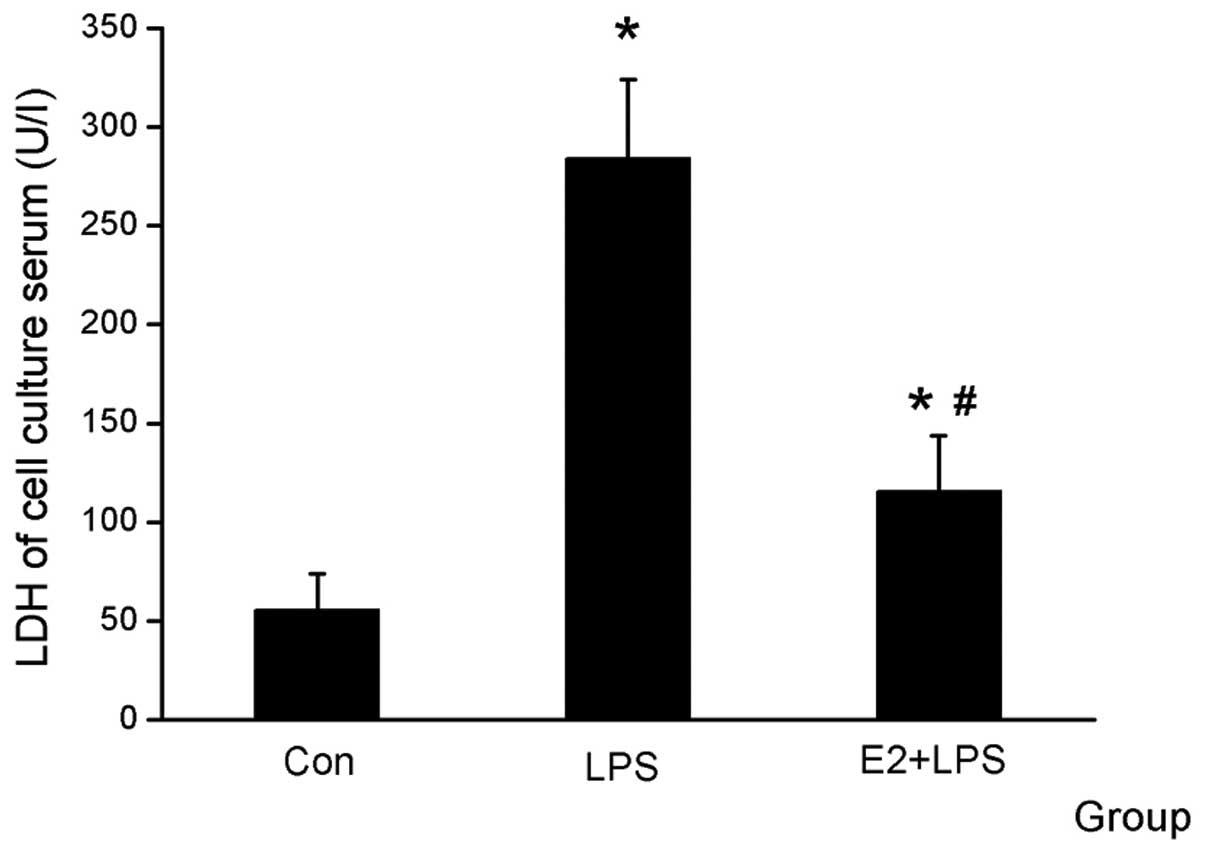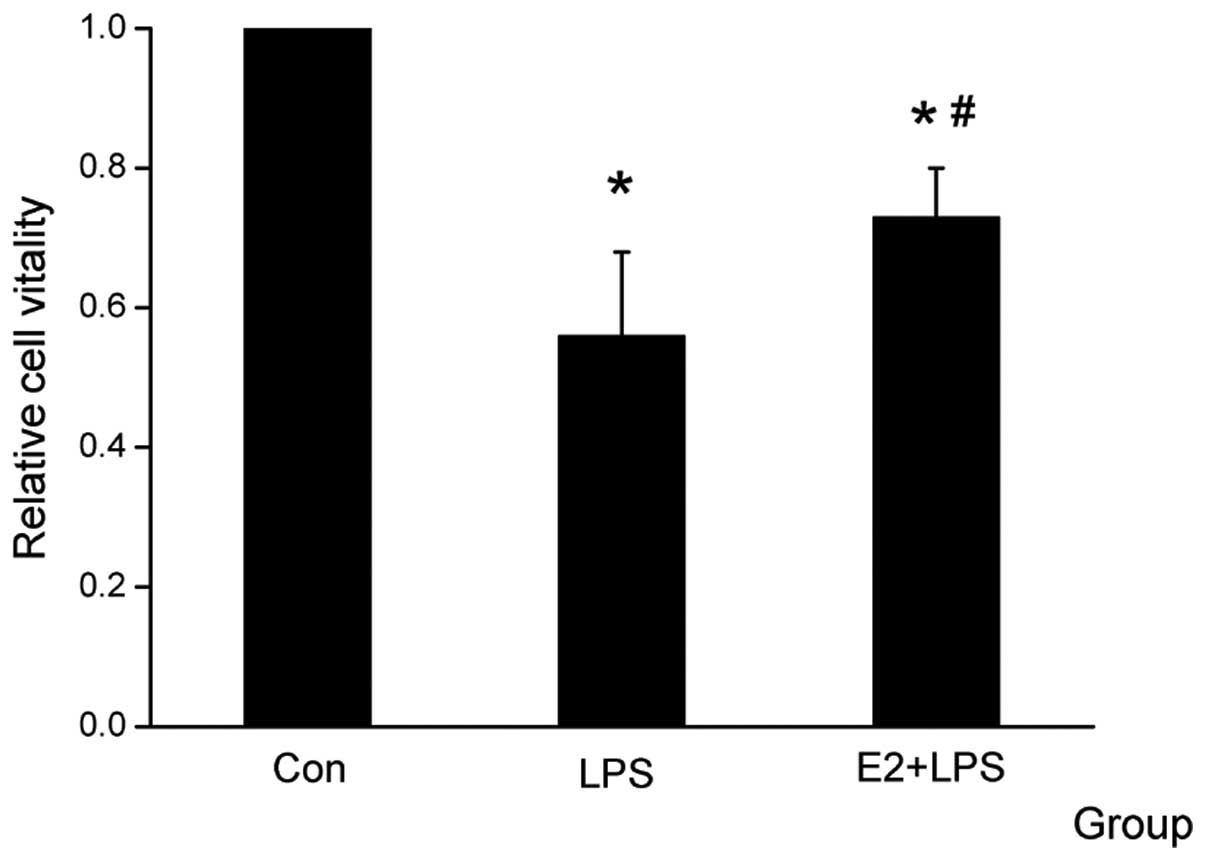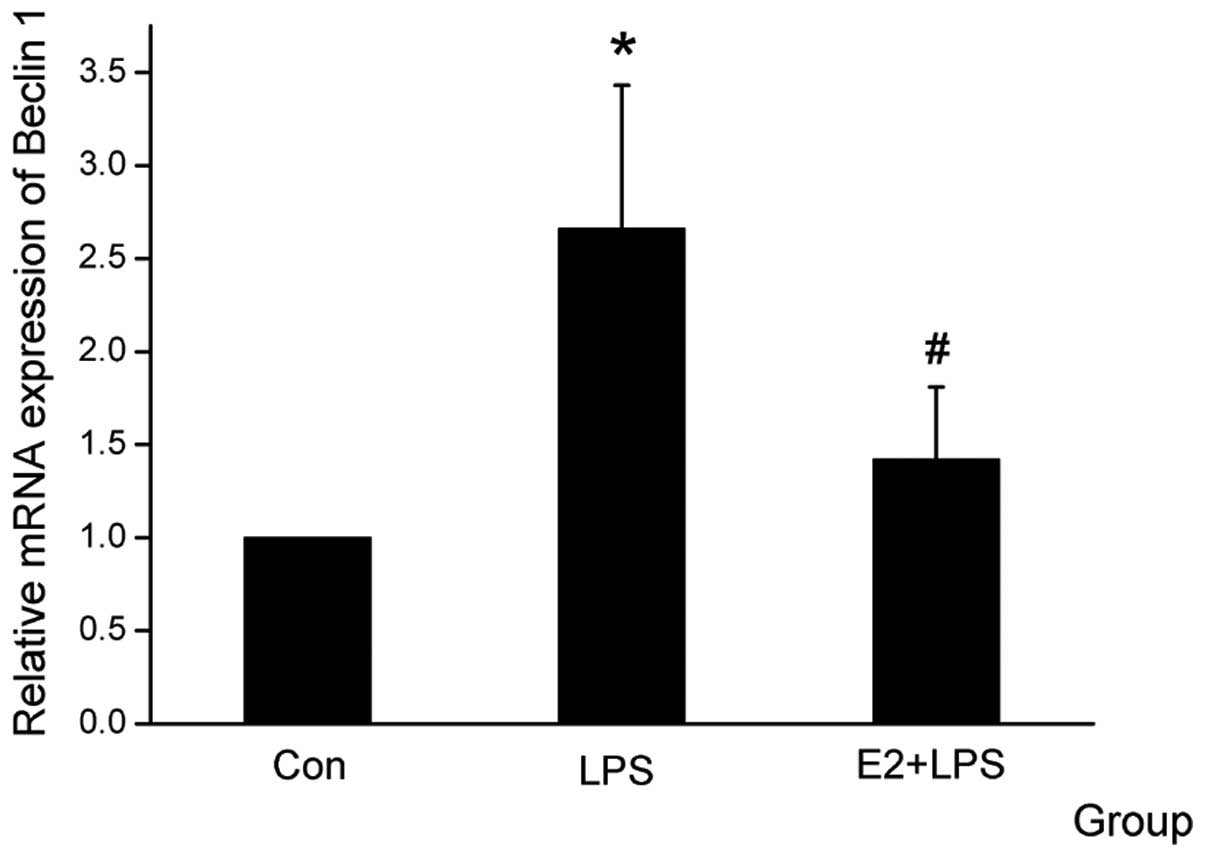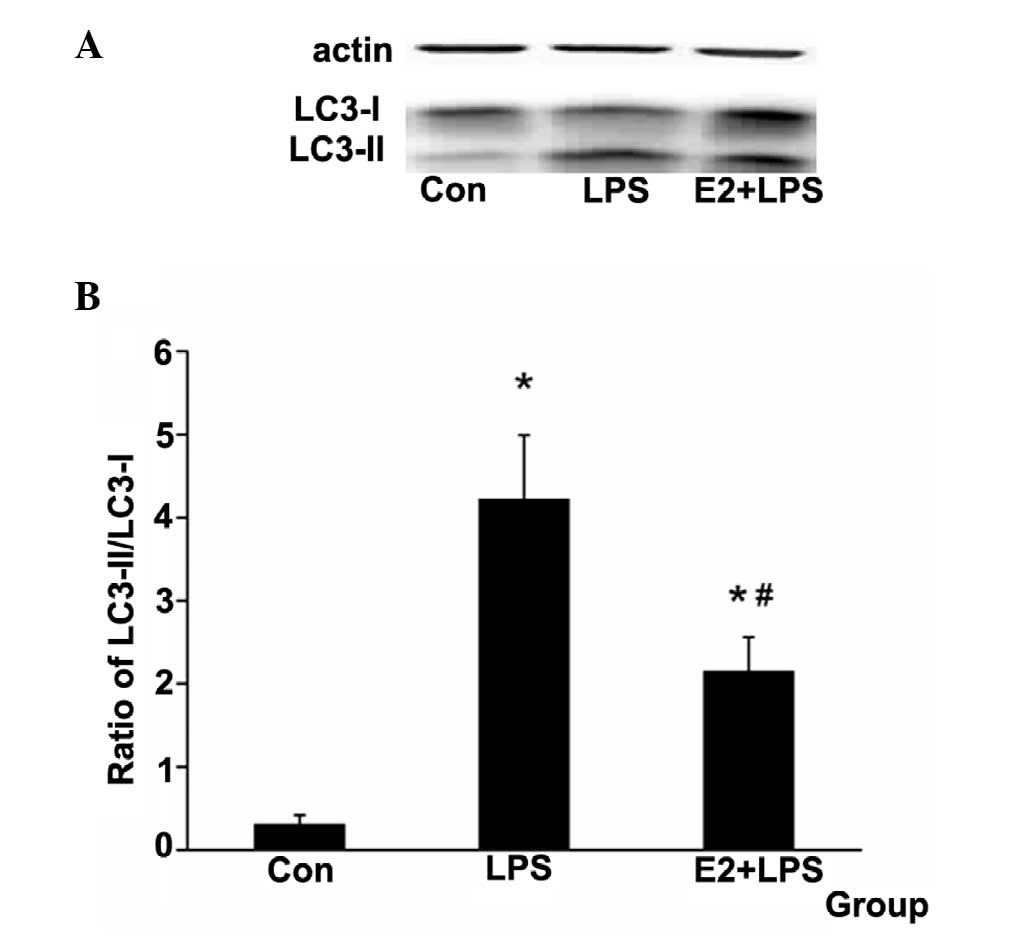|
1
|
Rudiger A and Singer M: The heart in
sepsis: from basic mechanisms to clinical management. Curr Vasc
Pharmacol. 11:187–195. 2013.PubMed/NCBI
|
|
2
|
Zhang M, Wang X, Wang X, et al: Oxymatrine
protects against myocardial injury via inhibition of JAK2/STAT3
signaling in rat septic shock. Mol Med Rep. 7:1293–1299.
2013.PubMed/NCBI
|
|
3
|
Hickson-Bick DL, Jones C and Buja LM:
Stimulation of mitochondrial biogenesis and autophagy by
lipopolysaccharide in the neonatal rat cardiomyocyte protects
against programmed cell death. J Mol Cell Cardiol. 44:411–418.
2008. View Article : Google Scholar
|
|
4
|
Yuan H, Perry CN, Huang C, et al:
LPS-induced autophagy is mediated by oxidative signaling in
cardiomyocytes and is associated with cytoprotection. Am J Physiol
Heart Circ Physiol. 296:H470–H479. 2009. View Article : Google Scholar : PubMed/NCBI
|
|
5
|
Smeding L, Plötz FB, Lamberts RR, van der
Laarse WJ, Kneyber MC and Groeneveld AB: Mechanical ventilation
with high tidal volumes attenuates myocardial dysfunction by
decreasing cardiac edema in a rat model of LPS-induced peritonitis.
Respir Res. 13:232012.
|
|
6
|
Tien YC, Lin JY, Lai CH, et al:
Carthamus tinctorius L. prevents LPS-induced TNFalpha
signaling activation and cell apoptosis through JNK1/2-NFkappaB
pathway inhibition in H9c2 cardiomyoblast cells. J Ethnopharmacol.
130:505–513. 2010. View Article : Google Scholar
|
|
7
|
Lorne E, Dupont H and Abraham E: Toll-like
receptors 2 and 4: initiators of non-septic inflammation in
critical care medicine? Intensive Care Med. 36:1826–1835. 2010.
View Article : Google Scholar : PubMed/NCBI
|
|
8
|
Leon CG, Tory R, Jia J, Sivak O and Wasan
KM: Discovery and development of toll-like receptor 4 (TLR4)
antagonists: a new paradigm for treating sepsis and other diseases.
Pharm Res. 25:1751–1761. 2008. View Article : Google Scholar : PubMed/NCBI
|
|
9
|
Turdi S, Han X, Huff AF, et al:
Cardiac-specific overexpression of catalase attenuates
lipopolysaccharide-induced myocardial contractile dysfunction: role
of autophagy. Free Radic Biol Med. 53:1327–1338. 2012. View Article : Google Scholar
|
|
10
|
Meléndez A, Tallóczy Z, Seaman M,
Eskelinen EL, Hall DH and Levine B: Autophagy genes are essential
for dauer development and life-span extension in C. elegans.
Science. 301:1387–1391. 2003.PubMed/NCBI
|
|
11
|
Stromhaug PE and Klionsky DJ: Approaching
the molecular mechanism of autophagy. Traffic. 2:524–531. 2001.
View Article : Google Scholar : PubMed/NCBI
|
|
12
|
Otto GP, Wu MY, Kazgan N, Anderson OR and
Kessin RH: Macroautophagy is required for multicellular development
of the social amoeba Dictyostelium discoideum. J Biol Chem.
278:17636–17645. 2003. View Article : Google Scholar : PubMed/NCBI
|
|
13
|
Vitale C, Mendelsohn ME and Rosano GM:
Gender differences in the cardiovascular effect of sex hormones.
Nat Rev Cardiol. 6:532–542. 2009. View Article : Google Scholar : PubMed/NCBI
|
|
14
|
Wenger NK: Clinical characteristics of
coronary heart disease in women: emphasis on gender differences.
Cardiovasc Res. 53:558–567. 2002. View Article : Google Scholar : PubMed/NCBI
|
|
15
|
Xu Y, Arenas IA, Armstrong SJ, Plahta WC,
Xu H and Davidge ST: Estrogen improves cardiac recovery after
ischemia/reperfusion by decreasing tumor necrosis factor-alpha.
Cardiovasc Res. 69:836–844. 2006. View Article : Google Scholar
|
|
16
|
Jian X, Xiao-yan Z, Bin H, et al: MiR-204
regulate cardiomyocyte autophagy induced by hypoxia-reoxygenation
through LC3-II. Int J Cardiol. 148:110–112. 2011. View Article : Google Scholar : PubMed/NCBI
|
|
17
|
Yue Z, Jin S, Yang C, Levine AJ and Heintz
N: Beclin 1, an autophagy gene essential for early embryonic
development, is a haploinsufficient tumor suppressor. Proc Natl
Acad Sci USA. 100:15077–15082. 2003. View Article : Google Scholar : PubMed/NCBI
|
|
18
|
Song X, Zhang X, Wang X, et al: Tumor
suppressor gene PDCD4 negatively regulates autophagy by inhibiting
the expression of autophagy-related gene ATG5. Autophagy.
9:743–755. 2013. View Article : Google Scholar : PubMed/NCBI
|
|
19
|
Nishida K, Kyoi S, Yamaguchi O, Sadoshima
J and Otsu K: The role of autophagy in the heart. Cell Death
Differ. 16:31–38. 2009. View Article : Google Scholar : PubMed/NCBI
|
|
20
|
Wu MJ, Wang L, Ding HY, Weng CY and Yen
JH: Glossogyne tenuifolia acts to inhibit inflammatory
mediator production in a macrophage cell line by downregulating
LPS-induced NF-kappa B. J Biomed Sci. 11:186–199. 2004.
|
|
21
|
Hou RC, Chen YS, Chen CH, Chen YH and Jeng
KC: Protective effect of 1,2,4-benzenetriol on LPS-induced NO
production by BV2 microglial cells. J Biomed Sci. 13:89–99. 2006.
View Article : Google Scholar : PubMed/NCBI
|
|
22
|
He B, Xiao J, Ren AJ, et al: Role of miR-1
and miR-133a in myocardial ischemic postconditioning. J Biomed Sci.
18:222011. View Article : Google Scholar : PubMed/NCBI
|
|
23
|
Whelan RS, Kaplinskiy V and Kitsis RN:
Cell death in the pathogenesis of heart disease: mechanisms and
significance. Annu Rev Physiol. 72:19–44. 2010. View Article : Google Scholar : PubMed/NCBI
|
|
24
|
Matsui Y, Takagi H, Qu X, et al: Distinct
roles of autophagy in the heart during ischemia and reperfusion:
roles of AMP-activated protein kinase and Beclin 1 in mediating
autophagy. Circ Res. 100:914–922. 2007. View Article : Google Scholar : PubMed/NCBI
|
|
25
|
Wong A, Grubb DR, Cooley N, Luo J and
Woodcock EA: Regulation of autophagy in cardiomyocytes by
Ins(1,4,5)P(3) and IP(3)-receptors. J Mol Cell Cardiol. 54:19–24.
2013. View Article : Google Scholar : PubMed/NCBI
|
|
26
|
Gurusamy N and Das DK: Is autophagy a
double-edged sword for the heart? Acta Physiol Hung. 96:267–276.
2009. View Article : Google Scholar : PubMed/NCBI
|
|
27
|
Martinet W, Agostinis P, Vanhoecke B,
Dewaele M and De Meyer GR: Autophagy in disease: a double-edged
sword with therapeutic potential. Clin Sci (Lond). 116:697–712.
2009. View Article : Google Scholar : PubMed/NCBI
|
|
28
|
Gottlieb RA and Mentzer RM: Autophagy
during cardiac stress: joys and frustrations of autophagy. Annu Rev
Physiol. 72:45–59. 2010. View Article : Google Scholar : PubMed/NCBI
|
|
29
|
Gottlieb RA, Finley KD and Mentzer RM Jr:
Cardioprotection requires taking out the trash. Basic Res Cardiol.
104:169–180. 2009. View Article : Google Scholar : PubMed/NCBI
|
|
30
|
Deschamps AM, Murphy E and Sun J: Estrogen
receptor activation and cardioprotection in ischemia reperfusion
injury. Trends Cardiovasc Med. 20:73–78. 2010. View Article : Google Scholar : PubMed/NCBI
|
|
31
|
Booth EA and Lucchesi BR:
Estrogen-mediated protection in myocardial ischemia-reperfusion
injury. Cardiovasc Toxicol. 8:101–113. 2008. View Article : Google Scholar : PubMed/NCBI
|
|
32
|
Nikolic I, Liu D, Bell JA, Collins J,
Steenbergen C and Murphy E: Treatment with an estrogen
receptor-beta-selective agonist is cardioprotective. J Mol Cell
Cardiol. 42:769–780. 2007. View Article : Google Scholar : PubMed/NCBI
|
|
33
|
Straface E, Vona R, Gambardella L, et al:
Cell sex determines anoikis resistance in vascular smooth muscle
cells. FEBS Lett. 583:3448–3454. 2009. View Article : Google Scholar : PubMed/NCBI
|
|
34
|
Jeanes HL, Tabor C, Black D, Ederveen A
and Gray GA: Oestrogen-mediated cardioprotection following
ischaemia and reperfusion is mimicked by an oestrogen receptor
(ER)alpha agonist and unaffected by an ER beta antagonist. J
Endocrinol. 197:493–501. 2008. View Article : Google Scholar
|
|
35
|
Lizotte E, Grandy SA, Tremblay A, Allen BG
and Fiset C: Expression, distribution and regulation of sex steroid
hormone receptors in mouse heart. Cell Physiol Biochem. 23:75–86.
2009. View Article : Google Scholar : PubMed/NCBI
|
|
36
|
Booth EA, Obeid NR and Lucchesi BR:
Activation of estrogen receptor-alpha protects the in vivo rabbit
heart from ischemia-reperfusion injury. Am J Physiol Heart Circ
Physiol. 289:H2039–H2047. 2005. View Article : Google Scholar : PubMed/NCBI
|














